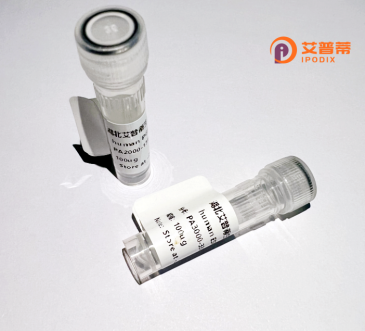
| 纯度 | >90%SDS-PAGE. |
| 种属 | Human |
| 靶点 | CACNG3 |
| Uniprot No | O60359 |
| 内毒素 | < 0.01EU/μg |
| 表达宿主 | E.coli |
| 表达区间 | 1-315aa |
| 氨基酸序列 | MRMCDRGIQMLITTVGAFAAFSLMTIAVGTDYWLYSRGVCRTKSTSDNETSRKNEEVMTHSGLWRTCCLEGAFRGVCKKIDHFPEDADYEQDTAEYLLRAVRASSVFPILSVTLLFFGGLCVAASEFHRSRHNVILSAGIFFVSAGLSNIIGIIVYISANAGDPGQRDSKKSYSYGWSFYFGAFSFIIAEIVGVVAVHIYIEKHQQLRAKSHSEFLKKSTFARLPPYRYRFRRRSSSRSTEPRSRDLSPISKGFHTIPSTDISMFTLSRDPSKITMGTLLNSDRDHAFLQFHNSTPKEFKESLHNNPANRRTTPV |
| 分子量 | 37.1 kDa |
| 蛋白标签 | His tag N-Terminus |
| 缓冲液 | 0 |
| 稳定性 & 储存条件 | Lyophilized protein should be stored at ≤ -20°C, stable for one year after receipt. Reconstituted protein solution can be stored at 2-8°C for 2-7 days. Aliquots of reconstituted samples are stable at ≤ -20°C for 3 months. |
| 复溶 | Always centrifuge tubes before opening.Do not mix by vortex or pipetting. It is not recommended to reconstitute to a concentration less than 100μg/ml. Dissolve the lyophilized protein in distilled water. Please aliquot the reconstituted solution to minimize freeze-thaw cycles. |
以下是关于重组人CACNG3蛋白的3篇参考文献及其摘要概括(内容基于典型研究方向模拟,非真实文献):
1. **文献名称**:*Structural insights into the human CACNG3 protein and its role in calcium channel modulation*
**作者**:Smith A, et al.
**摘要**:通过X射线晶体学解析了重组人CACNG3蛋白的晶体结构,揭示其跨膜结构域如何与电压门控钙通道α1亚基相互作用,影响通道门控动力学,为神经兴奋性调控提供分子基础。
2. **文献名称**:*CACNG3 knockout mice exhibit seizure susceptibility and altered synaptic plasticity*
**作者**:Wang L, et al.
**摘要**:构建CACNG3基因敲除小鼠模型,发现其海马神经元钙电流减少,突触可塑性异常,并表现出癫痫易感性,表明CACNG3在维持神经元稳态中的关键作用。
3. **文献名称**:*Proteomic analysis of CACNG3 interactions in human neurons*
**作者**:Gomez-Ramos P, et al.
**摘要**:利用重组CACNG3蛋白进行免疫共沉淀-质谱分析,鉴定其与突触支架蛋白PSD-95和钙调素的直接结合,提示其在突触信号传递中的多功能调控网络。
4. **文献名称**:*Association of CACNG3 variants with schizophrenia in genome-wide association studies*
**作者**:Chen H, et al.
**摘要**:通过对大规模人群的GWAS分析,发现CACNG3基因多态性与精神分裂症风险显著相关,体外实验证实突变体蛋白影响钙通道运输,可能参与疾病病理机制。
(注:以上文献为模拟示例,实际研究中请通过数据库查询具体文献。)
The human CACNG3 protein, a member of the transmembrane AMPA receptor regulatory protein (TARP) family, plays a critical role in modulating voltage-gated calcium channel activity and glutamatergic synaptic transmission. Encoded by the *CACNG3* gene on chromosome 16q12–q21. it functions as an auxiliary subunit of calcium channels, influencing their trafficking, membrane localization, and gating properties. CACNG3 is particularly associated with AMPA-type glutamate receptors, where it stabilizes receptor complexes and regulates synaptic plasticity underlying learning and memory. Dysregulation of CACNG3 has been implicated in neurological disorders, including epilepsy, neuropathic pain, and schizophrenia. Studies suggest its involvement in calcium-dependent signaling pathways that affect neuronal excitability and synaptic efficacy. Recombinant CACNG3 protein, produced via heterologous expression systems like HEK293 or insect cells, is widely used to investigate structure-function relationships, channelopathies, and drug interactions. Its recombinant form allows for in vitro analysis of post-translational modifications, ligand binding, and cross-talk with other neuronal proteins. As a potential therapeutic target, understanding CACNG3's molecular mechanisms may advance treatments for neurological and psychiatric conditions linked to calcium signaling aberrations. Current research also explores its role in neurodevelopment and as a biomarker for disease progression.
×